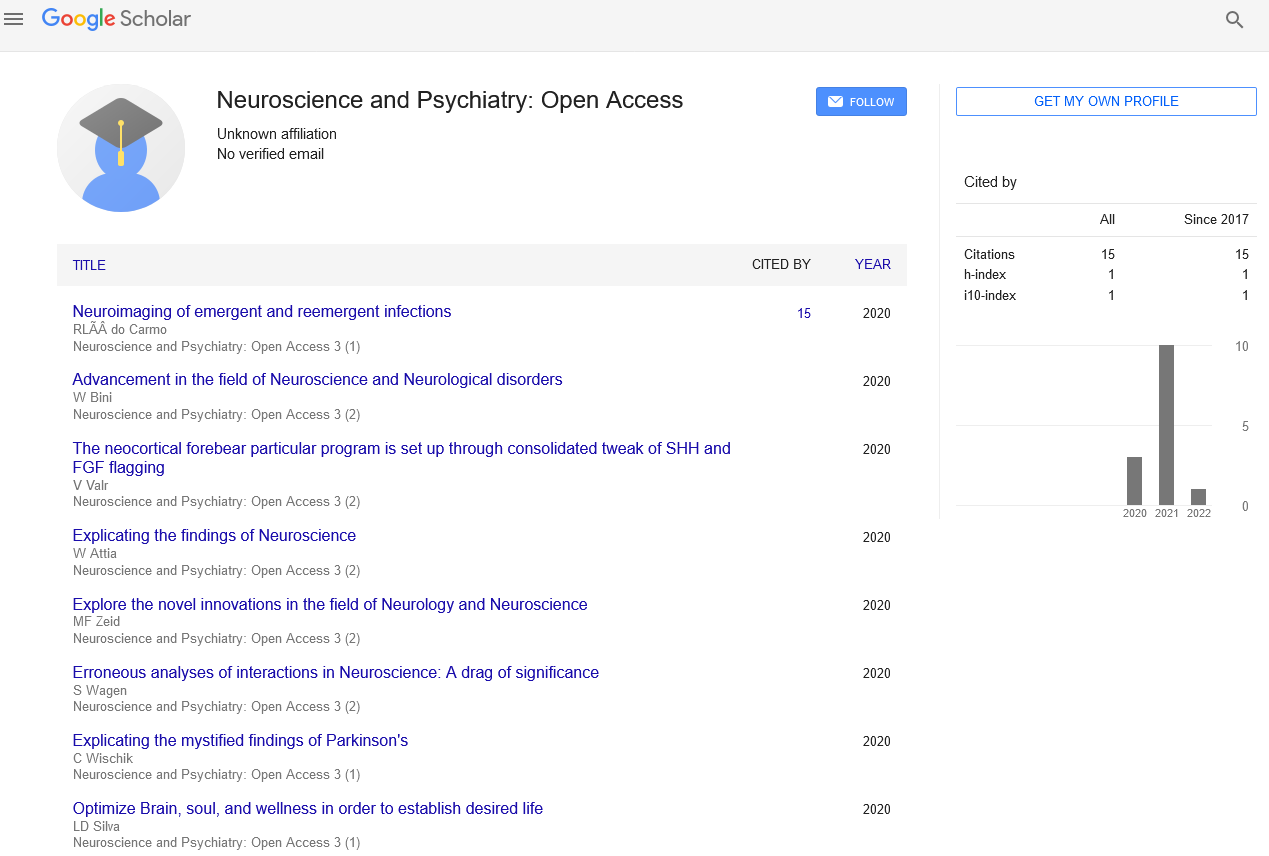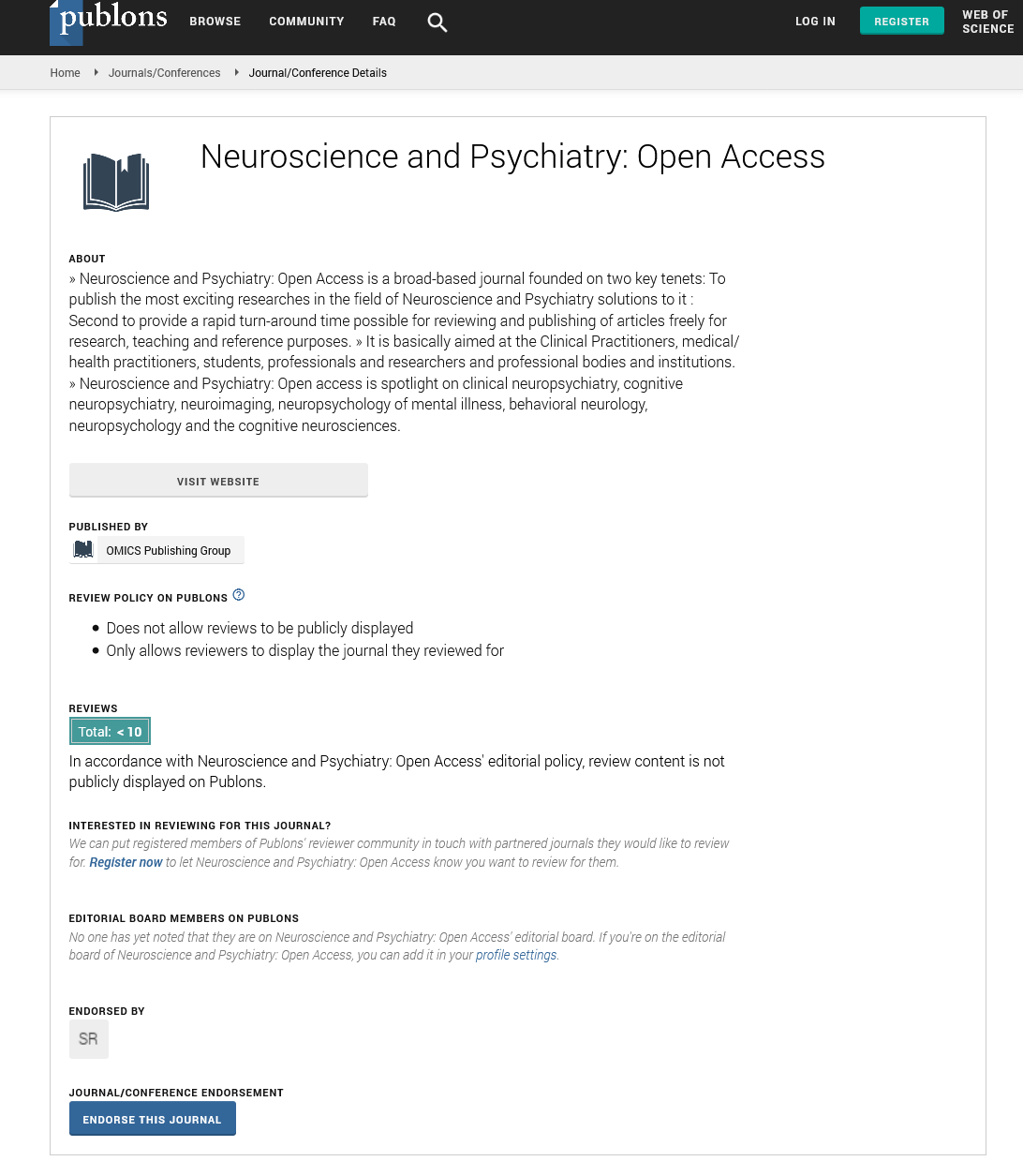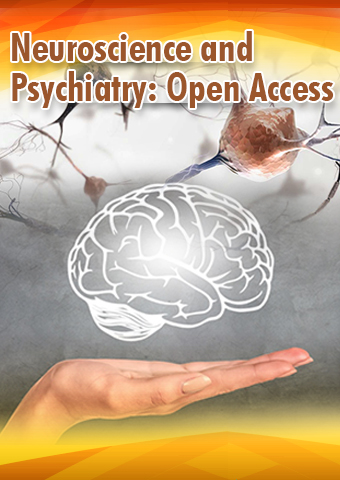Perspective - Neuroscience and Psychiatry: Open Access (2024) Volume 7, Issue 4
Deciphering Schizophrenia: Unraveling the Enigma in Neuroscience and Psychiatry
- Corresponding Author:
- Can-Jun Ruan
Department of Physiology, University of Hong Kong, Hong Kong, China
E-mail: Rcjjent5@ccmu.edu.cn
Received: 18-06-2024, Manuscript No. NPOA-24-133876; Editor assigned: 21-06-2024, PreQC No. NPOA-24-133876 (PQ); Reviewed: 05-07-2024, QC No. NPOA-24-133876; Revised: 15-07-2024, Manuscript No. NPOA-24-133876 (R); Published: 22-07-2024, DOI: 10.47532/npoa.2024.7(4).232-233
Introduction
Schizophrenia stands as one of the most enigmatic and complex mental disorders, weaving a tapestry of cognitive distortions, perceptual disruptions, and emotional dysregulation. In this comprehensive exploration, we delve into the multifaceted nature of schizophrenia, encompassing its clinical presentation, neurobiological underpinnings, diagnostic challenges, treatment modalities, and avenues for future research within the realms of neuroscience and psychiatry.
Description
The spectrum of schizophrenia: Clinical manifestations and subtypes
Schizophrenia manifests along a spectrum of symptoms that encompass positive symptoms (e.g., hallucinations, delusions), negative symptoms (e.g., affective flattening, social withdrawal), cognitive deficits (e.g., impaired working memory, executive dysfunction), and disorganized speech and behavior. These symptoms often fluctuate in severity and may be accompanied by mood disturbances, anxiety, and impaired insight into illness.
Subtypes of schizophrenia, including paranoid, disorganized, catatonic, residual, and undifferentiated types, reflect the heterogeneity and varied symptom profiles observed in individuals with this disorder. The Diagnostic and Statistical Manual of mental disorders (DSM-5) and the International Classification of Diseases (ICD-11) provide diagnostic criteria and guidelines for differentiating schizophrenia from other psychotic disorders and medical conditions.
Neurobiology of schizophrenia: Insights from neuroscience research
Neuroscientific investigations into schizophrenia have uncovered abnormalities in brain structure, function, and connectivity that underlie the disorder’s pathophysiology. Neuroimaging studies, such as Magnetic Resonance Imaging (MRI), Positron Emission Tomography (PET), and functional MRI (fMRI), reveal structural changes in brain regions implicated in emotion regulation (e.g., amygdala), cognitive control (e.g., prefrontal cortex), and sensory processing (e.g., thalamus).
Dysregulation of neurotransmitter systems, particularly dopamine, glutamate, and Gamma- Aminobutyric Acid (GABA), plays a central role in the neurochemistry of schizophrenia. Excessive dopamine activity in mesolimbic pathways contributes to positive symptoms, while hypoactivity in mesocortical pathways is associated with cognitive deficits and negative symptoms. Glutamatergic dysfunction and alterations in GABAergic transmission further contribute to synaptic dysregulation and neural circuitry disruptions observed in schizophrenia.
Challenges in diagnosis and differential diagnosis
Diagnosing schizophrenia presents challenges due to its complex symptomatology, overlap with other psychiatric conditions, and variability in symptom expression over time. Differential diagnosis involves ruling out medical causes, substance-induced psychosis, mood disorders with psychotic features, and other primary psychotic disorders to ensure accurate classification and treatment planning.
The prodromal phase of schizophrenia, characterized by subtle changes in behavior, cognition, and affect, poses diagnostic dilemmas as these early signs may mimic non-specific stress reactions or other psychiatric conditions. Early intervention programs and psychosis risk assessment tools aid in identifying individuals at heightened risk for developing schizophrenia, enabling timely interventions and support services.
Treatment approaches: From pharmacotherapy to psychosocial interventions
The management of schizophrenia integrates pharmacological interventions, psychosocial therapies, and supportive services to address the multidimensional needs of individuals with this disorder. Antipsychotic medications, categorized as typical (first-generation) and atypical (second-generation) agents, target dopamine receptor blockade and alleviate positive symptoms, albeit with varying side effect profiles.
Psychosocial interventions, including Cognitive-Behavioral Therapy (CBT), family therapy, supported employment programs, and Assertive Community Treatment (ACT), complement pharmacotherapy by addressing negative symptoms, enhancing social functioning, improving medication adherence, and fostering recovery-oriented care. Early intervention services, crisis intervention teams, and peer support networks form integral components of comprehensive schizophrenia treatment plans.
Emerging trends and research directions
Advancements in neuroscience, genetics, neuroimaging, and digital health technologies are reshaping the landscape of schizophrenia research and treatment. Genomic studies identify genetic risk variants, polygenic risk scores, and gene-environment interactions that contribute to schizophrenia susceptibility, paving the way for precision medicine approaches and targeted interventions.
Neuroimaging techniques, such as Diffusion Tensor Imaging (DTI) and functional connectivity analyses, elucidate aberrant neural circuits, white matter abnormalities, and connectivity disruptions associated with schizophrenia. Translational research initiatives bridge bench-to-bedside gaps, facilitating the development of novel therapeutics, neural circuit modulation strategies, and biomarker discovery for schizophrenia subtypes and treatment-resistant cases.
Future directions: Towards personalized psychiatry and recovery-oriented care
Looking ahead, the future of schizophrenia research and clinical practice embraces personalized psychiatry paradigms that tailor interventions to individualized symptom profiles, genetic signatures, treatment response patterns, and psychosocial needs. Collaborative consortia, data sharing initiatives, and international collaborations accelerate knowledge translation, replication studies, and validation of biomarkers and therapeutic targets.
Recovery-oriented care models emphasize holistic approaches that empower individuals with schizophrenia to reclaim agency, cultivate resilience, pursue meaningful life goals, and achieve optimal quality of life. Advocacy efforts, destigmatization campaigns, and community integration initiatives promote social inclusion, reduce treatment disparities, and foster supportive environments for individuals living with schizophrenia and their families.
Conclusion
In conclusion, neuroplasticity represents a dynamic and adaptive process that shapes brain structure, function, and connectivity throughout life. From developmental milestones to recovery from injuries and disorders, neuroplasticity underscores the brain’s remarkable capacity for change, learning, and adaptation. By embracing neuroplasticity, neuroscience and psychiatry converge to unlock new frontiers in brain health, personalized treatments, and resilienceenhancing strategies that empower individuals to thrive and flourish amidst life’s challenges.
As we navigate the complexities of neuroplasticity, interdisciplinary collaborations, technological innovations, and a deeper understanding of brain-behavior relationships propel us towards a future where precision neuroscience, personalized interventions, and brain resilience initiatives converge to optimize brain health and well-being for all.


